Part of a series of articles titled Park Paleontology News - Vol. 13, No. 1, Spring 2021.
Article
From the Ashes: how volcanologists can help paleontologists reconstruct the ancient past at Hagerman Fossil Beds National Monument

Emily Thorpe, M.S., Geoscientists-in-the-Parks Guest Scientist, and Kari Prassack, PhD., Lead Paleontologist
Hagerman Fossil Beds National Monument
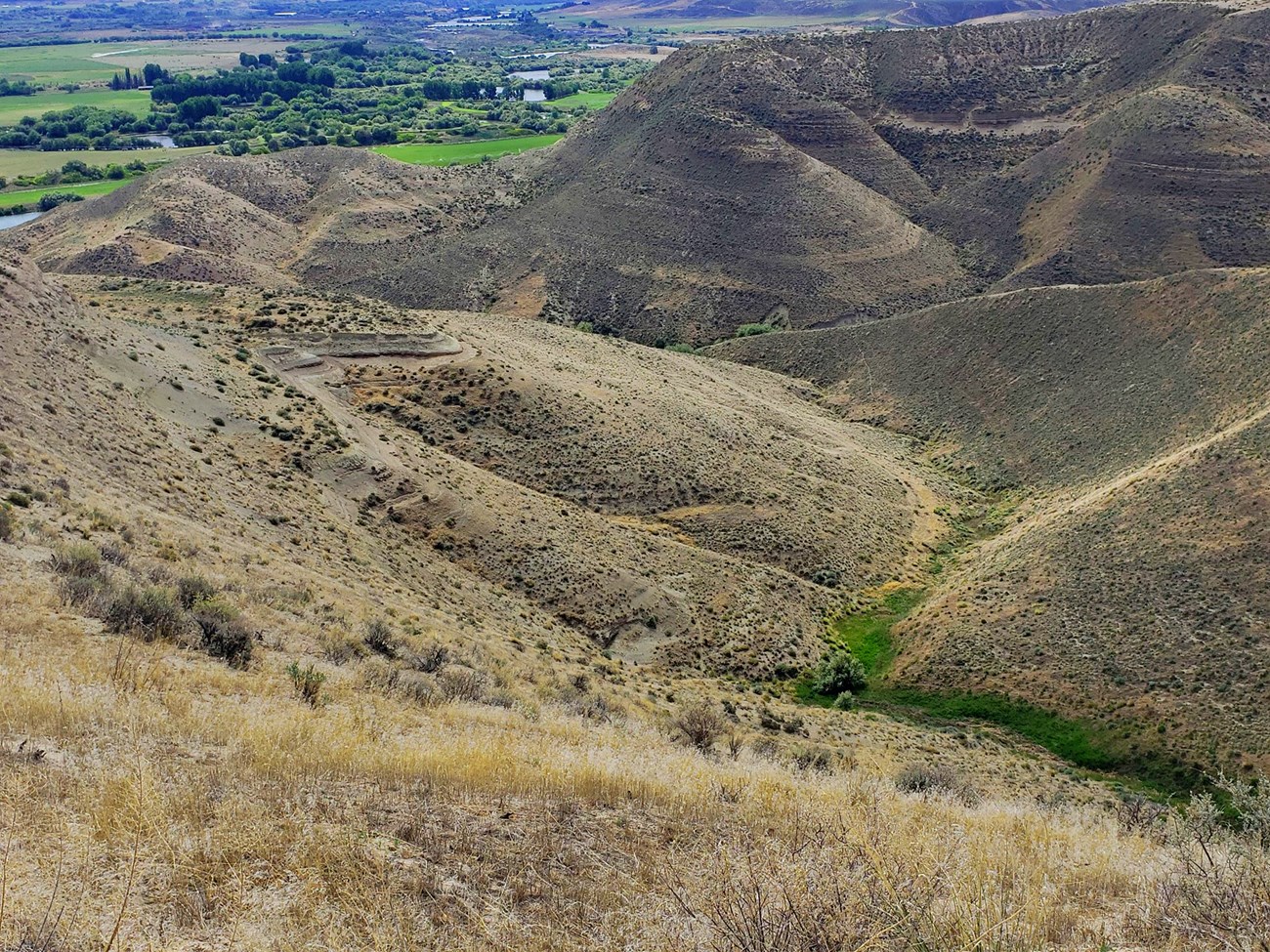
The Hagerman Fossil Beds (Figure 1) of south-central Idaho are best known for the Smithsonian Horse Quarry, but fossil sites are spread across the monument’s steep bluffs with a vertical spread of 600 feet and a horizontal spread of approximately 4,350 acres. These sites preserve a rich ecosystem of some 200 species including rodents, birds, frogs, and many carnivorans, like otters, canids, and saber-toothed cats. Larger animals, like mastodons and giant ground sloths, are also found but less common.
Hagerman’s fossils range from approximately 4.2 to 3.07 million years in age. We might look to Hagerman as a single “snapshot” or “window” into the Pliocene Epoch, but a very time-averaged one. By comparison, this would be like lumping humans and animals of today’s Anthropocene Epoch with those of the Holocene and much of the Pleistocene ice ages. We need better resolution than that, but our fossils are too old to still preserve carbon for direct C14 dating.
Although our fossils are too old, our volcanic ashes are the perfect age for dating. The dating, tracing, and mapping of ashes (tephra) deposited by past volcanic events is called tephrochronology. Following the laws of superposition, a layer of fossils will be younger than the ash below it and older than the ash that caps it. This allows us to date fossils based on to their location relative to these ashes. Previous studies at Hagerman dated some ash outcrops and then projected those dates across the monument. This was considered accurate enough because Hagerman was interpreted as a relatively flat floodplain that showed little variance in rates of sediment deposition or erosion. But tectonic faulting and the scouring and deposition of land by Hagerman’s river and lake created a landscape that was anything but flat. Projecting a few isolated ashes was not enough for the type of resolution paleontologists want for reconstructing ancient environments.
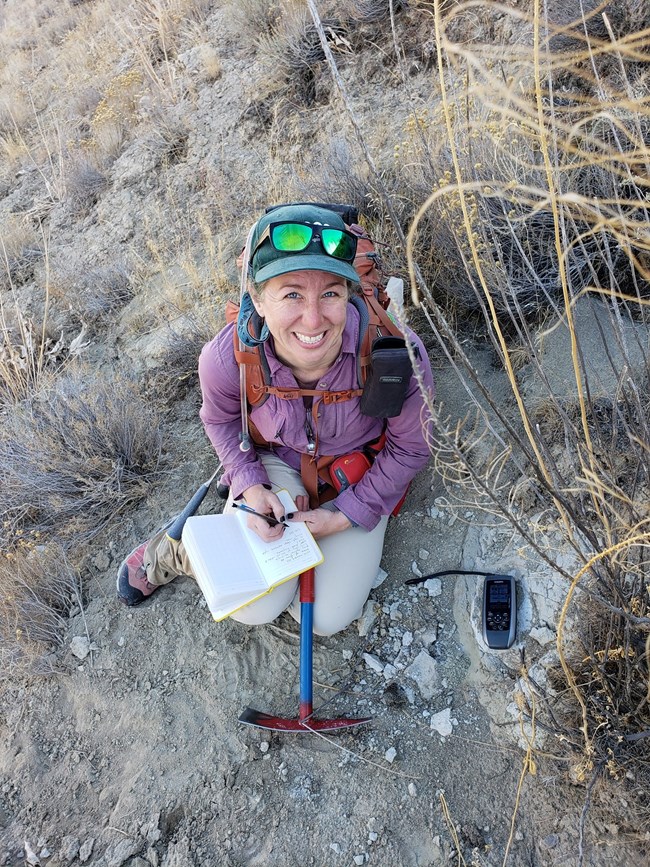
It was with this need in mind that the Hagerman Paleontology, Environments, and Tephrochronology (PET) Project was formed. This project’s rock star is geologist Laura Walkup of the U.S. Geological Survey’s Tephrochronology Project (Figure 2). Starting in 2016, Laura Walkup has spent part of each summer meticulously discovering ashes and tracing them across Hagerman’s bluffs. This has been a daunting project with many steep slopes (Figure 3) to traverse and a lot of digging to find outcrops of ash hidden under mounds of sediment and vegetation. Laura then took these samples back to the lab and used a variety of analytical methods to identify their unique chemical signatures so she could accurately map these ashes across the monument.
Laura’s hard work has paid off, with 13 volcanic ashes identified and traced across the monument. Of these, most were previously only known from single outcrops and several were not even known to exist! We can now separate Hagerman’s fossil sites into 14 distinct time slices representing 14 distinct faunal communities and associated environments! This higher resolution will help create a better understanding of animal behavior, community-level structure, and climate change at Hagerman.
Hagerman’s guest scientist, Emily Thorpe, recently sat down with Laura to learn more about her work and her experiences at Hagerman.
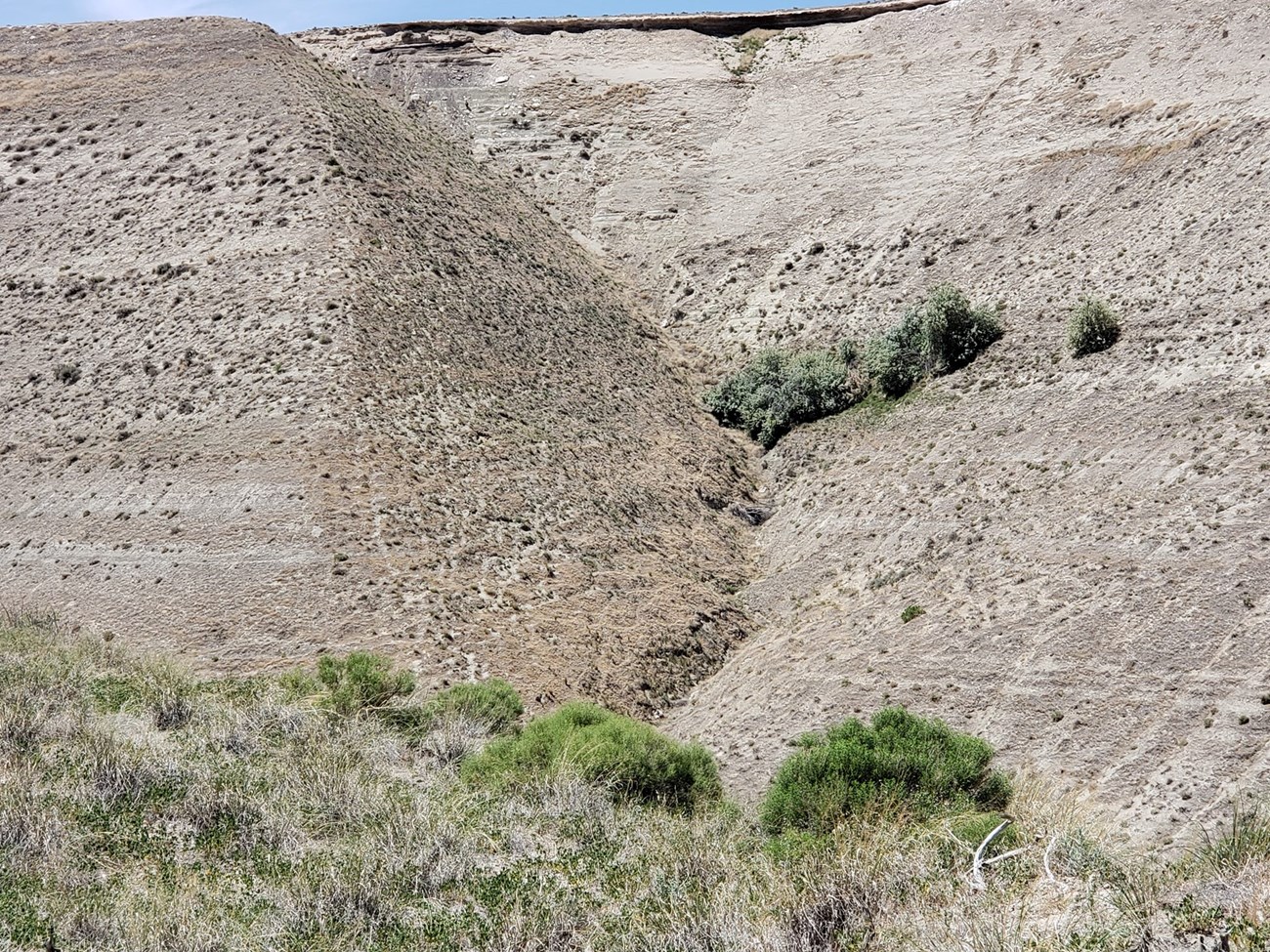
Emily. Tell me a little about yourself.
Laura. I have a Master’s degree in volcanology and I did my masters research in Ethiopia, using tephrochronology to provide context for hominid evolution, so very similar to what we’re doing at Hagerman, with somewhat similar geology, and age ranges, but different fossil species. My master’s advisor was Dr. Bill Hart at Miami University. He and his former students actually did some tephra work at Hagerman in the late 1990’s. After grad school, I got a GeoCorps position at Mount Rainier National Park and started working seasonally throughout the park service. One of the many positions I applied for was an interpretive position at Hagerman. I worked at Hagerman for a few months, which is when I got to know Dr. Kari Prassack. After that, I worked a few other seasonal positions with the NPS before my current position with the USGS Tephrochronology Project.
Emily. How did you get involved in the PET Project?
Laura. Kari and I had a conversation about my new job [at USGS] and we realized that I was in a position to do the work that Kari had been wanting done for a while. Previous geologists in the 1960s did regional tephra mapping that included Hagerman, but they only published data on two gulches in Hagerman. Bill Hart and his former students Matt Brueseke and C.B. Minturn also looked at limited sites in and around the monument and later publications have taken the elevation of dated ash layers and projected them across the entire monument. With no other information this is a reasonable thing to do, but the sediments are all dipping shallowly to the west and there are some faults in the monument and differential sedimentation rates from place to place. We finagled funding for me to come in 2016 and do a pilot study, which went really well. Then we got a USGS-NRPP grant to do a multiyear project.
Emily. What’s your favorite/least favorite part of field work?
Laura. I love being in the field, so my favorite part of field work in Hagerman is just being in the field. One of the special things about doing field work in a place that is closed to the public is that it is very solitary, and I can really get in touch with nature. I like that. My least favorite thing is maybe the rattlesnakes. No, you know what’s worse than the rattlesnakes? The tumbleweeds. There are tumble mustard and Russian thistle, both invasive, all over the monument. They fill up the gullies and so when you’re trying to cross a gully you look at it and think “ok is this a layer of two tumbleweeds or am I going to step in here and sink up to my neck and drown in tumbleweeds?” (Figure 4). Cheatgrass is also the worst – my least favorite things are all the invasive plants that cover up my beautiful geology. It also gets really hot and dusty and sometimes going up and down those hills is surprisingly strenuous.
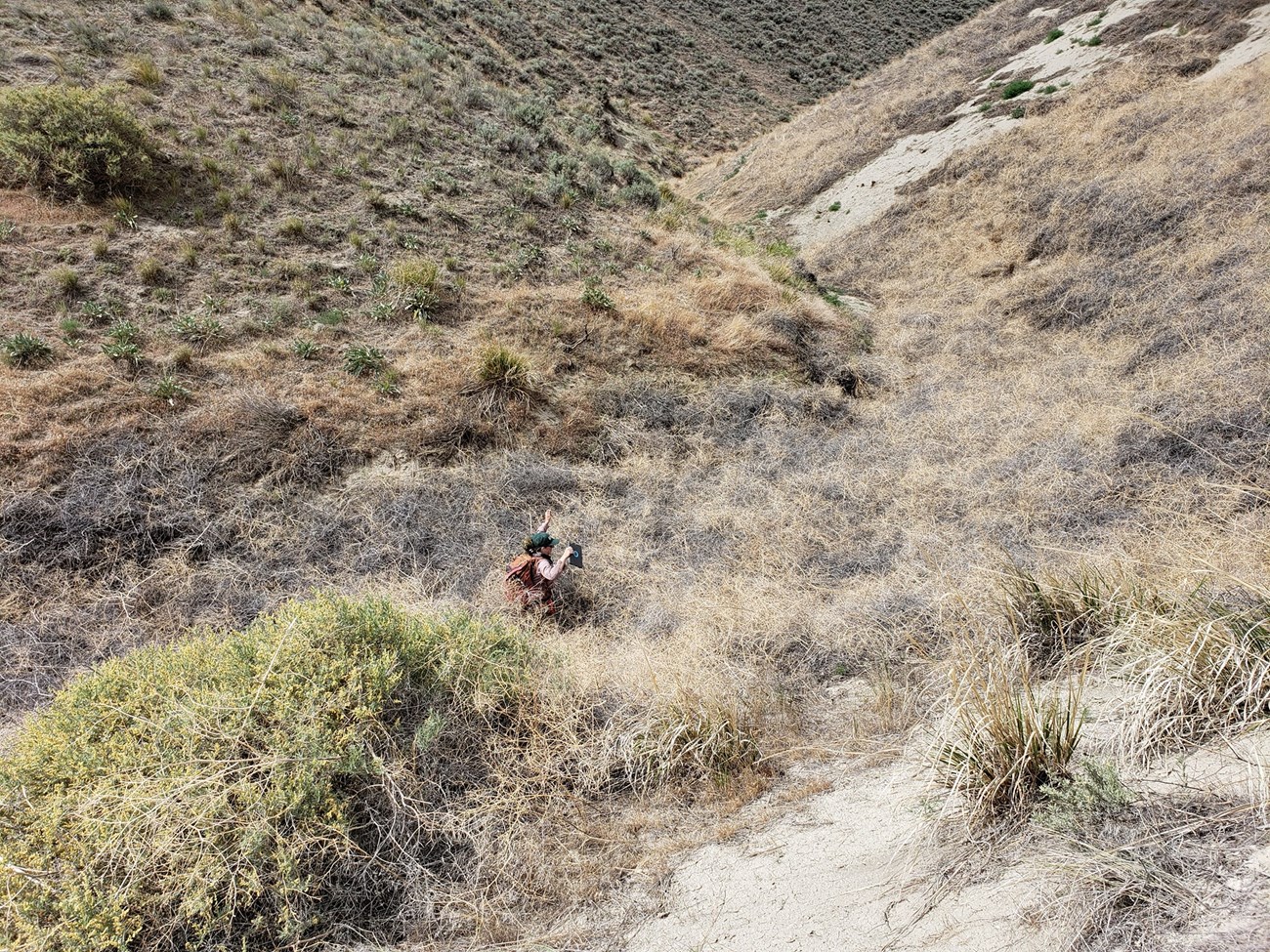
Emily. How does Hagerman compare to somewhere else you have worked?
Laura. In Ethiopia, most of the places where we were mapping, we were able to drive up quite close to the site and rarely had to hike long distances. At Hagerman that is not the case. For the most part we’re parking at the top of everything and hiking down into gullies, and then at the end of the day with my pack full of samples I have to hike back up to the top of the hills to the car. The topography in the two places are similar though, and the degree of lithification and how the tephra is preserved are quite similar.
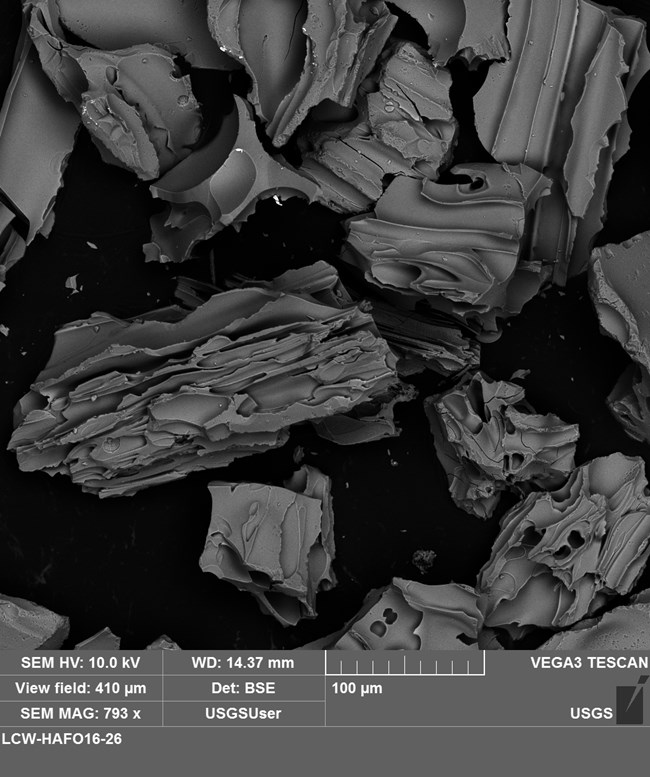
Emily. How would you explain the analysis process to someone who isn’t familiar with it?
Laura. Every magma chamber has a unique geochemical composition that results from the composition of the rock that melted to form the magma and how long the magma has been sitting around and percolating. Different magma chambers can have similar chemistries, but they won’t be exactly the same. In an explosive volcanic eruption, bits of magma are thrown into the air and cool very quickly, forming volcanic glass which is the main component of volcanic ash or tephra. These shards of volcanic glass (Figure 5) preserve the unique geochemical composition of the magma chamber.
Minerals also form in the magma chamber and those are important for dating ash layers, but the main thing that I’m doing is using the geochemistry of the glass to match ashes from one deposit to another. Using this chemistry and looking at the sediments above and below the ash layers, I can make sure that a deposit in one gully is from the same eruption as a deposit in a similar stratigraphic context the next gully over. Volcanic eruptions are geologically instantaneous events that can be age dated if they have the right minerals in them. Usually the farther away from the eruption source, the less likely you are to have those minerals because they tend to be heavier than glass shards and not travel as far. Because of this and other reasons we cannot always date every deposit of volcanic ash but, if we analyze the geochemistry we might be able to match an undatable deposit to a near-source deposit from the same eruption that we can get an age for.
Emily. Could there be tephra layers that weren’t identified?
Laura. Absolutely. I have done quite detailed tephra mapping and over the course of the past 3 years I identified several new ash layers that no one had identified previously. Some of them are quite subtle and it’s not a surprise that no one has found them because in some cases, I had been working there a few years before I found them. There are areas of the monument where you have younger deposits that we didn’t spend as much time in because they historically haven’t produced as many fossils. It is possible that there are layers that we haven’t found simply because we haven’t been looking in the right place. Even though ash is usually initially deposited fairly evenly across the landscape, that doesn’t mean it will be preserved everywhere. If the ash is deposited into a river, it’s going to get washed downstream. If it falls on a higher elevation it can get eroded away, but if it falls into a marsh or a deep lake it will often be preserved as it fell. It’s even possible that we would find other layers within the same stratigraphic horizons that we’ve looked at a lot, but they’re only preserved in one specific spot. Some of the layers that I found are like that, they’re only preserved in the northern half of the monument and they’re thin and poorly preserved, possibly from smaller eruptions or maybe there were differences in deposition between the northern and southern part of the monument.
Emily. What is the highest resolution we can achieve with this age dating technique?
Laura. That really depends on the technique you use and what mineral you date. Some common ways to date tephra are via argon/argon dating of feldspars, uranium/lead dating of zircons, or there are even some less precise ways to date the glass shards themselves, but those techniques require the glass to be unaltered, which is not a guarantee.
Emily. What is the next step for you and this project?
Laura. I’m still analyzing samples, and so the next steps for me are finishing analysis of samples I’ve already collected and then writing up and publishing our data. Ideally, Kari and I would love to get a sedimentologist/stratigrapher involved in the project, someone who can look at the stratigraphy in detail across the monument and help tie together the environmental context of the various sites through time. We want to put everything together holistically and tell a story about how this monument preserves at least a million years of evolution. Not every fossil found in the monument was alive at the same time. Telling a better story about which of these critters were coexisting and in what context would be exciting.
Kari and I have also talked about tying Hagerman to some of the other fossil sites in and around Idaho using this tephra analysis. One of the things I really like about this project is the interdisciplinary nature of it and how we’re trying to do a more holistic view of looking at everything at once instead of working off in our own little bubbles and only caring about our own separate scientific problems. I enjoy using the volcanology as a tool to answer questions about things that I am not personally an expert in, like fossil evolution, climate change, and how the physical world has changed over time. I think that makes my work more interesting to a broader range of people. I also think that working with people who have a different background is important. Everyone has a different viewpoint and approaches things differently, examining things from different angles. This type of collaboration can lead to a more diverse way of considering the same problem and is more likely to result in solutions that I would not necessarily be able to come up with on my own.
Related Links
- Hagerman Fossil Beds National Monument, Idaho—[Geodiversity Atlas] [Park Home]
- NPS—Fossils Through Geologic Time
- NPS—Fossils and Paleontology
- NPS—Geology
Last updated: March 15, 2021
